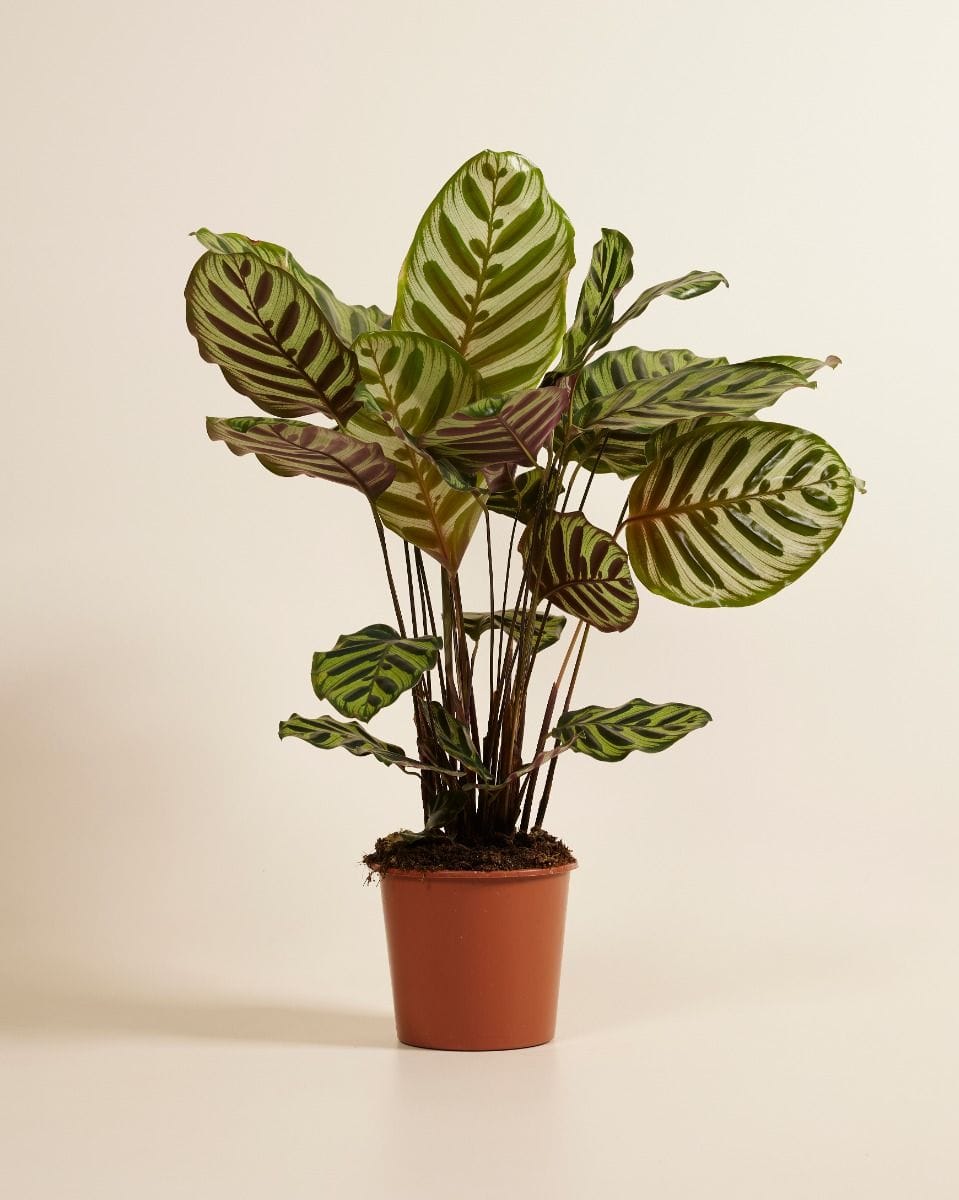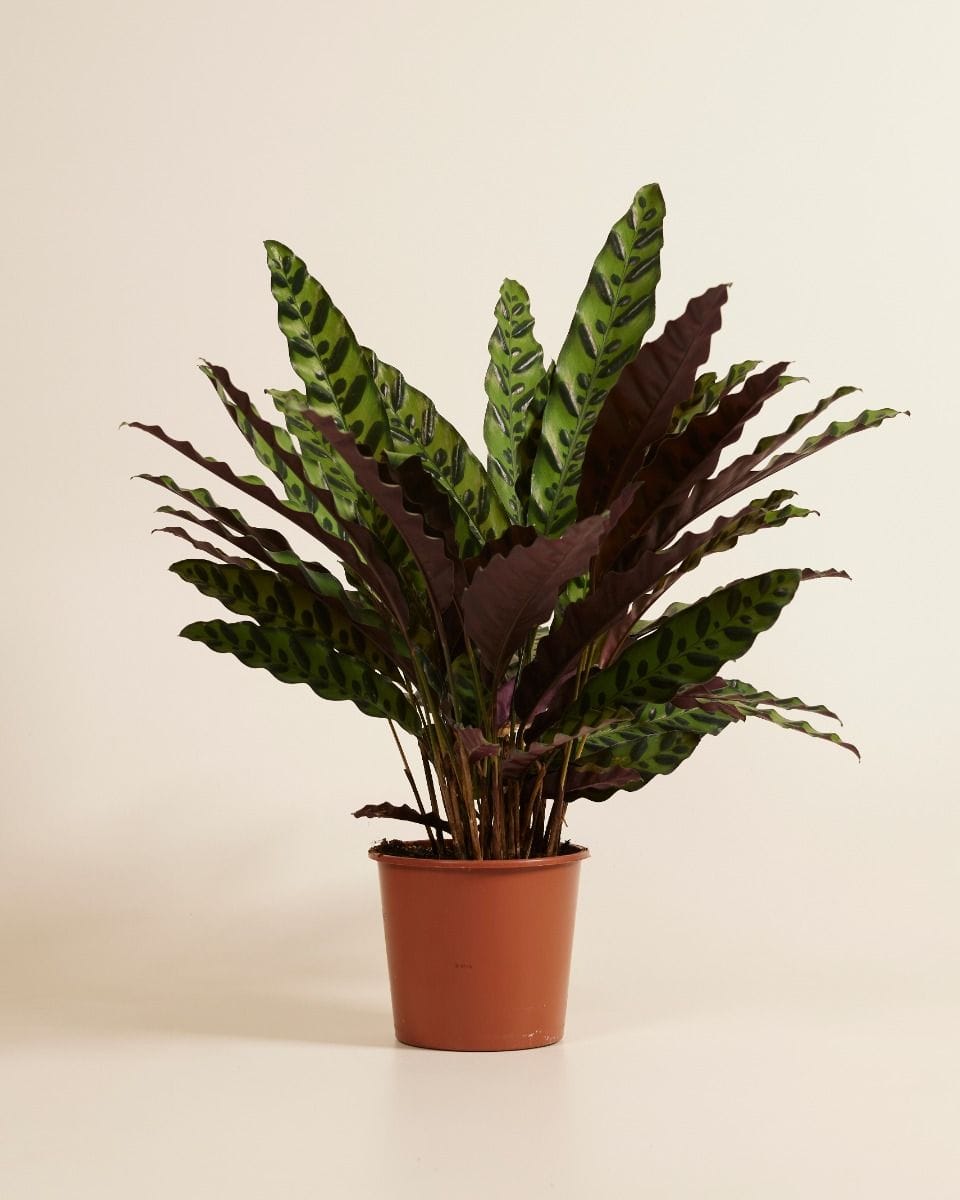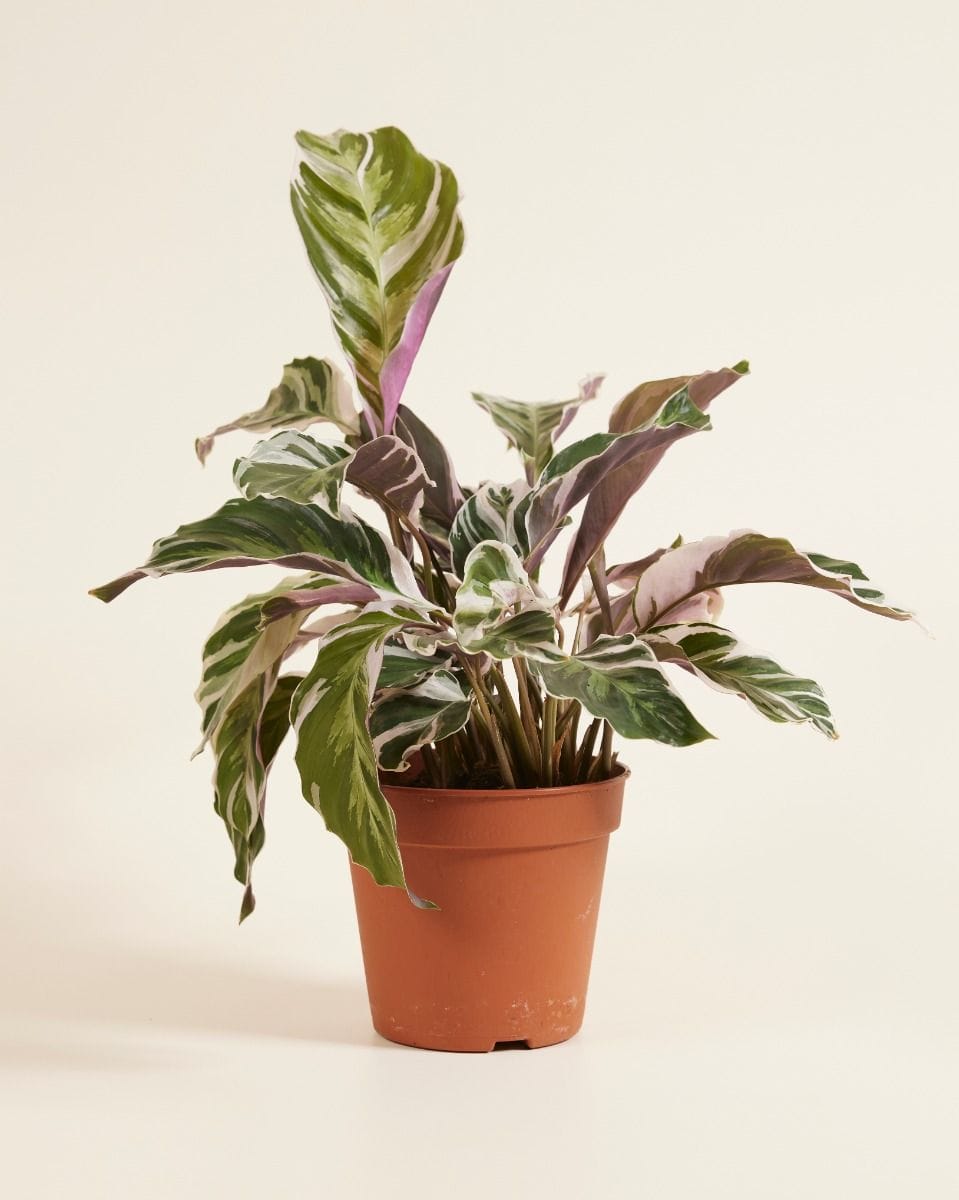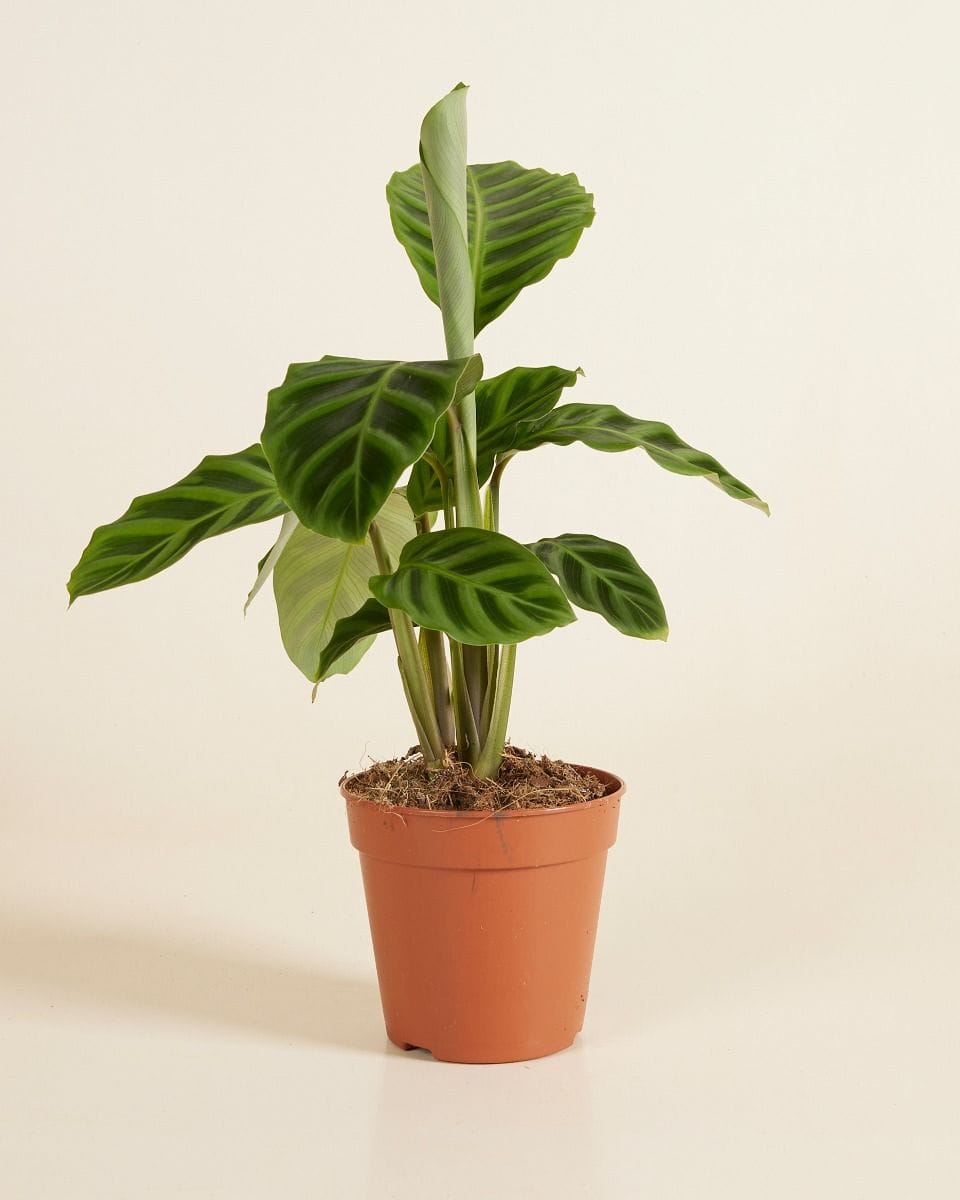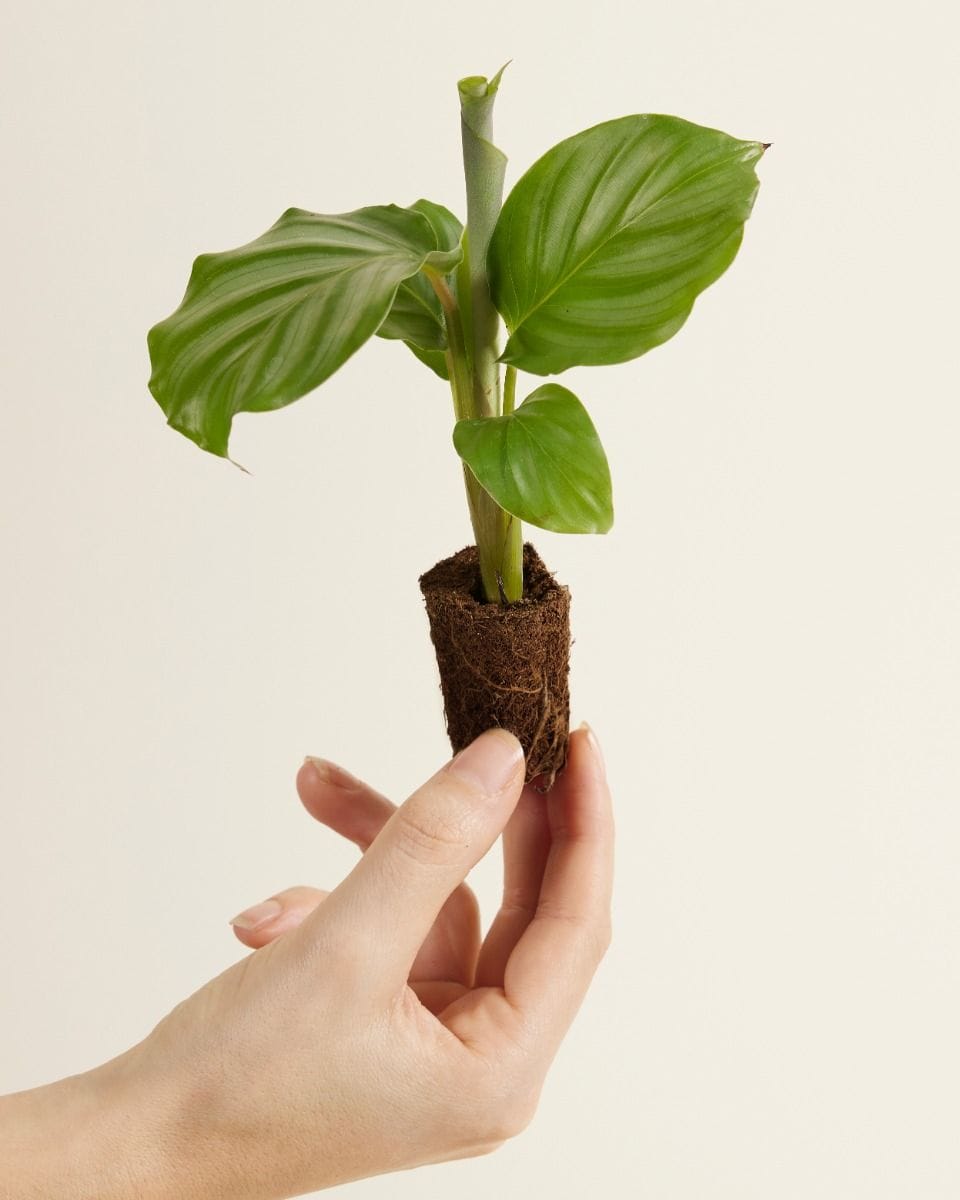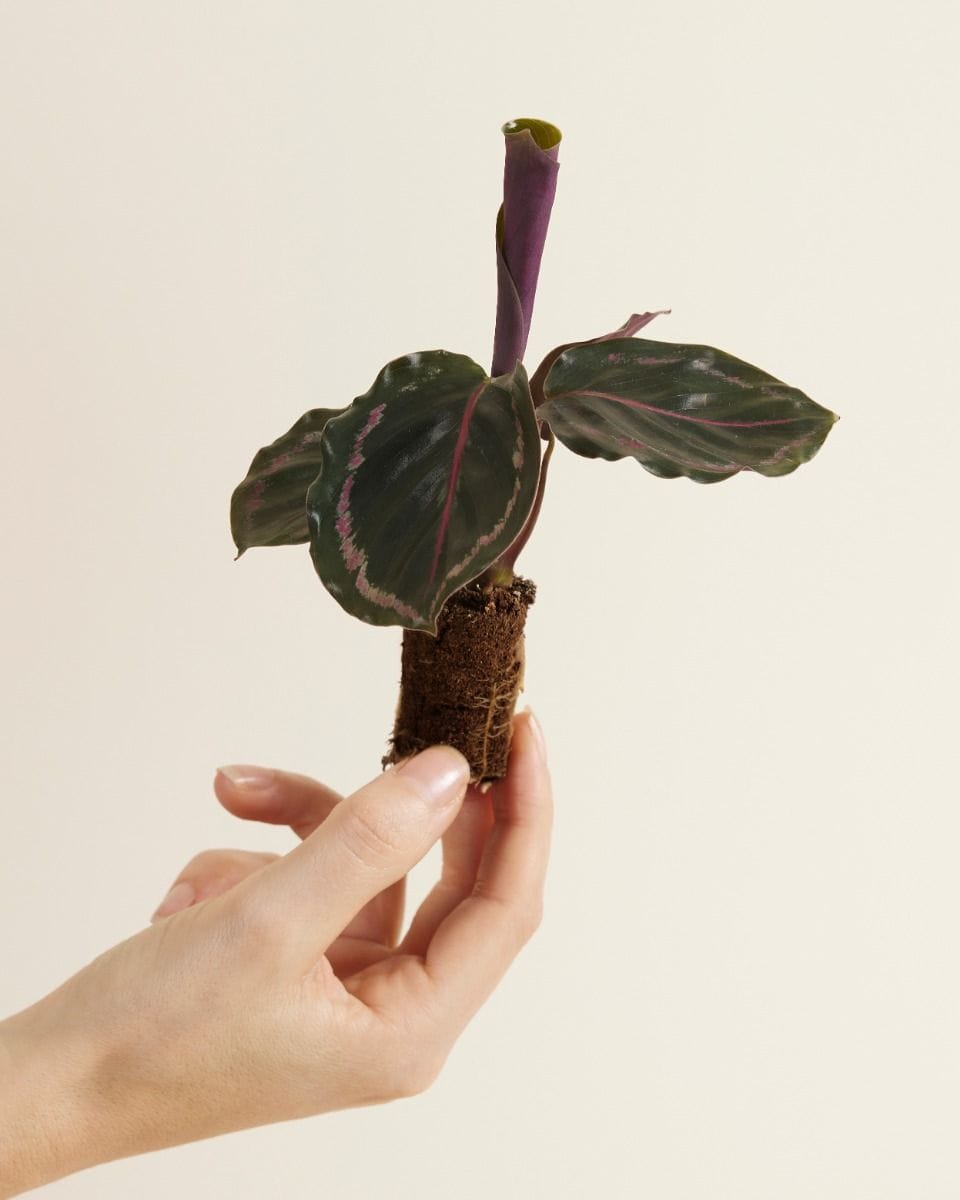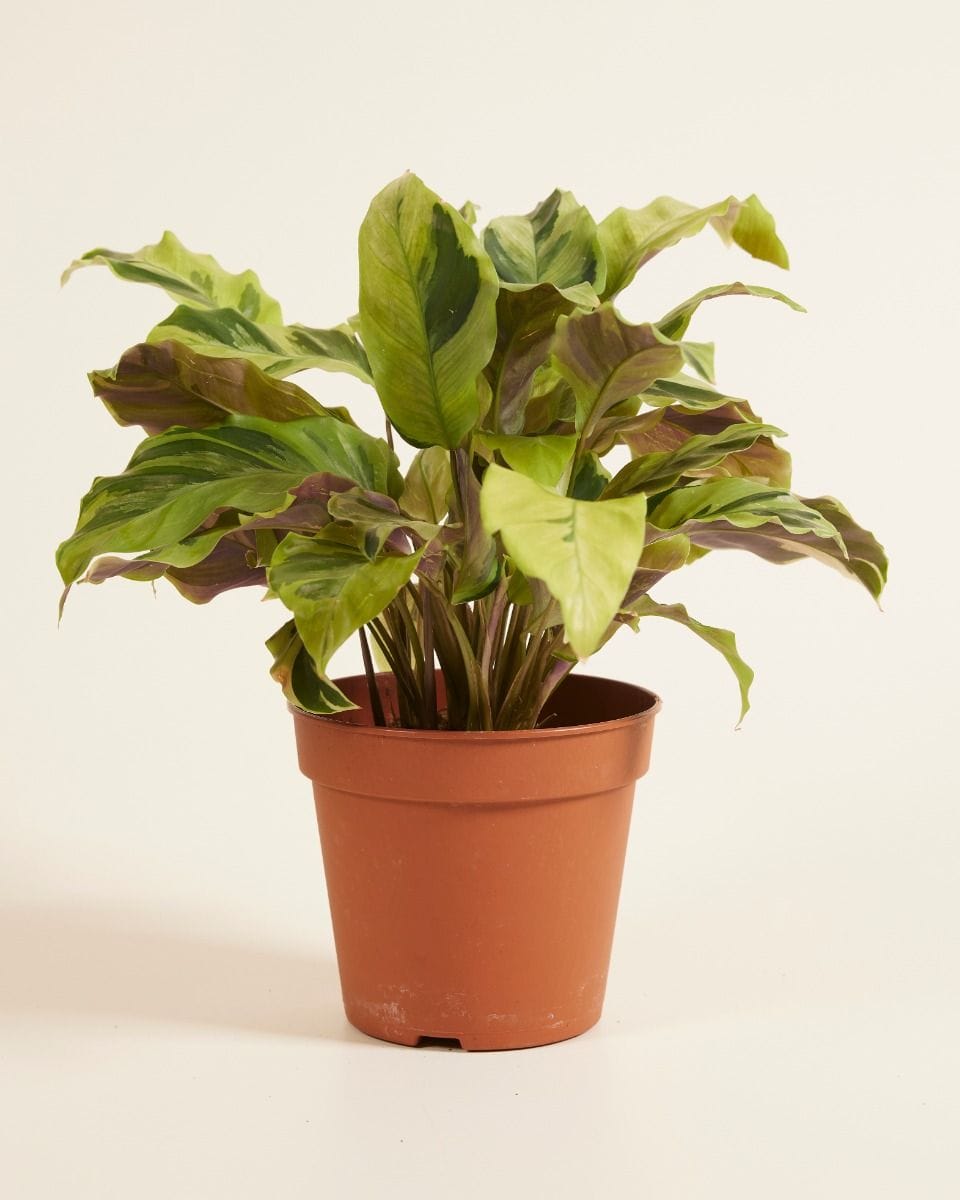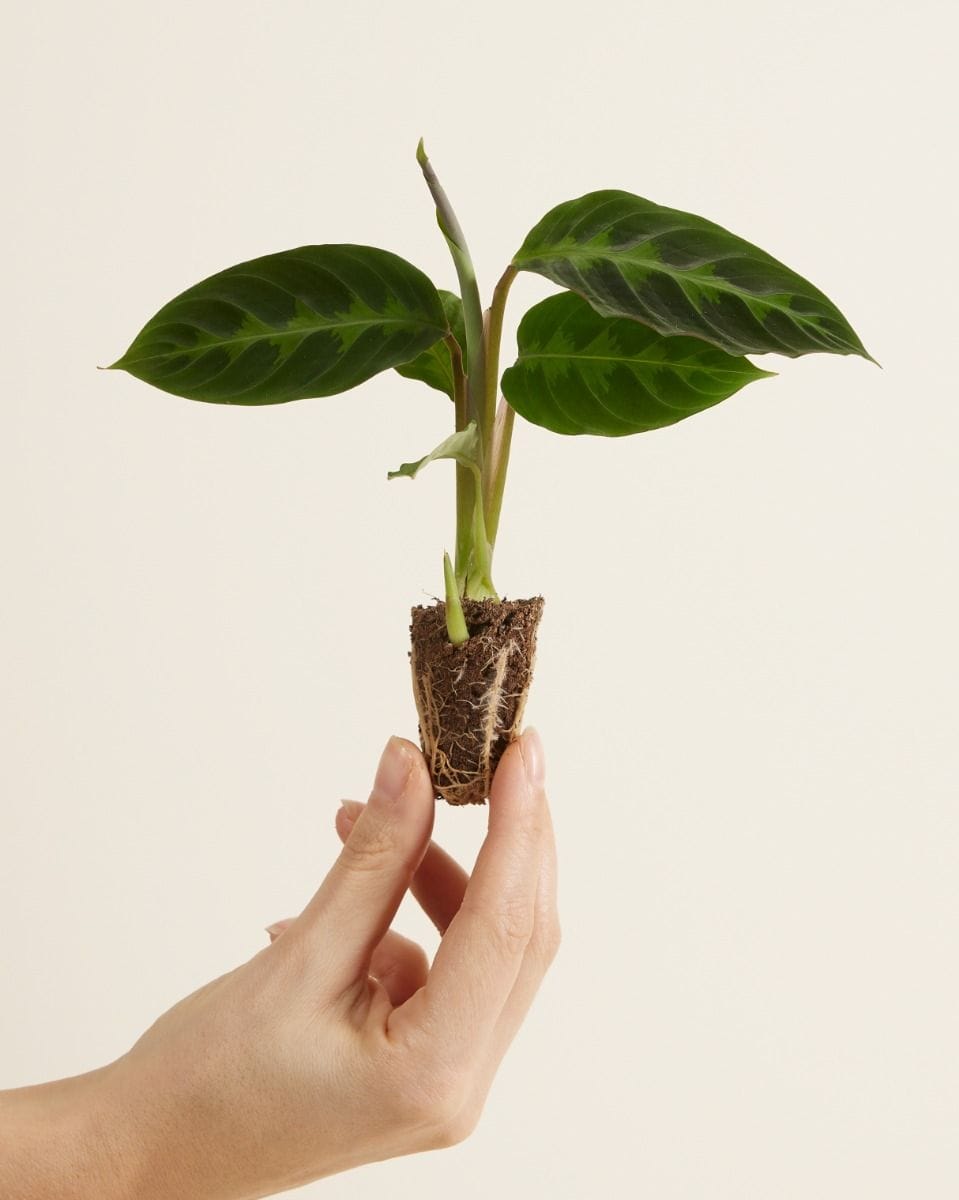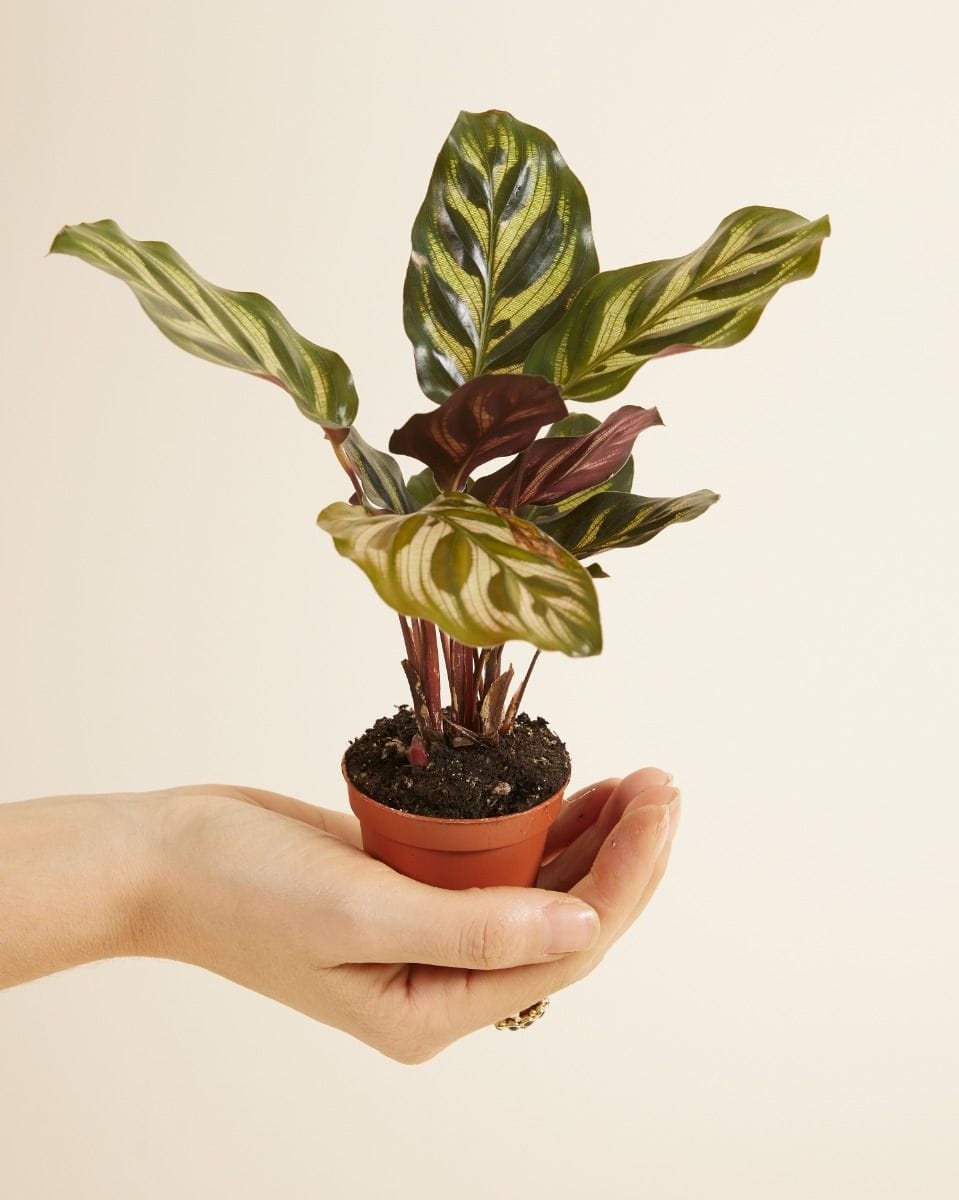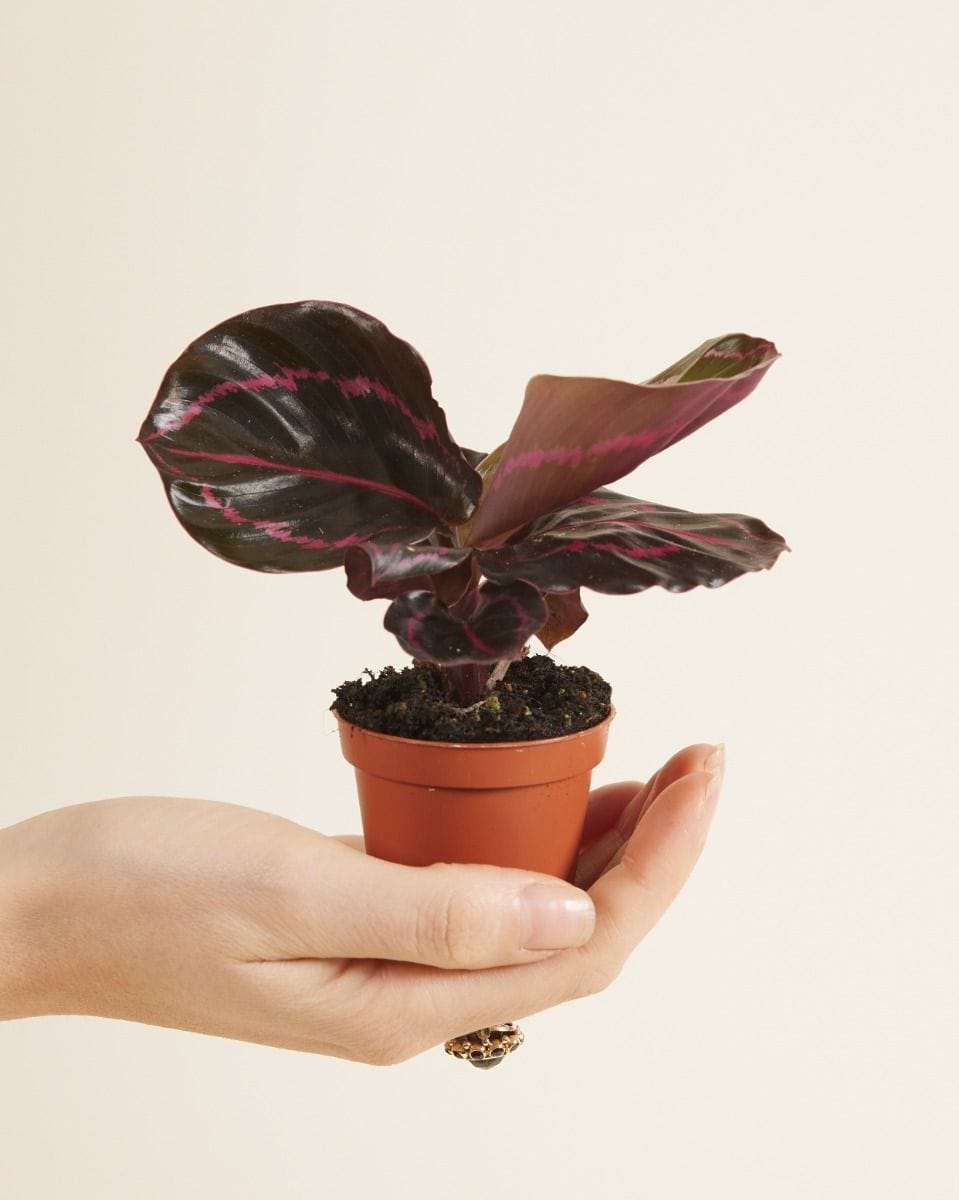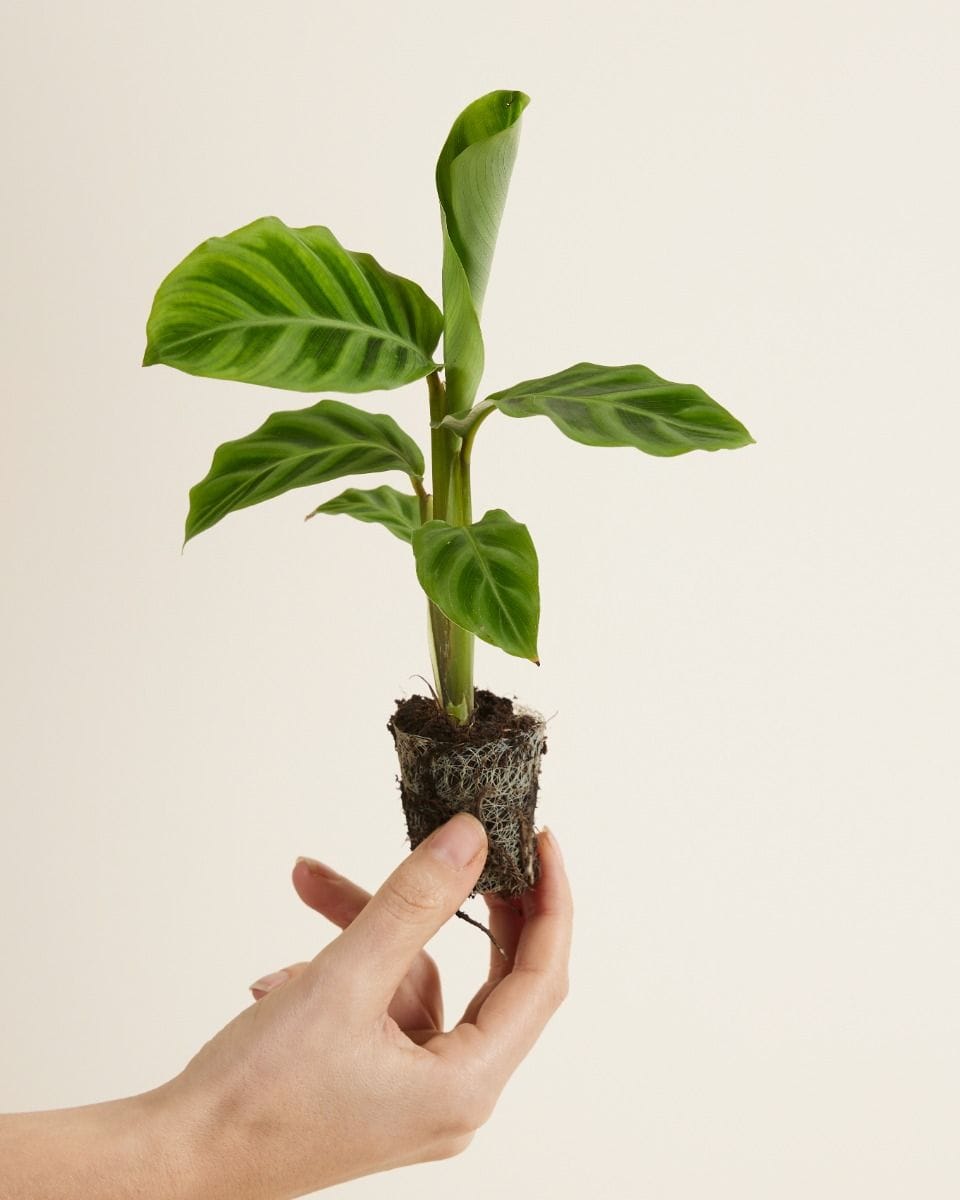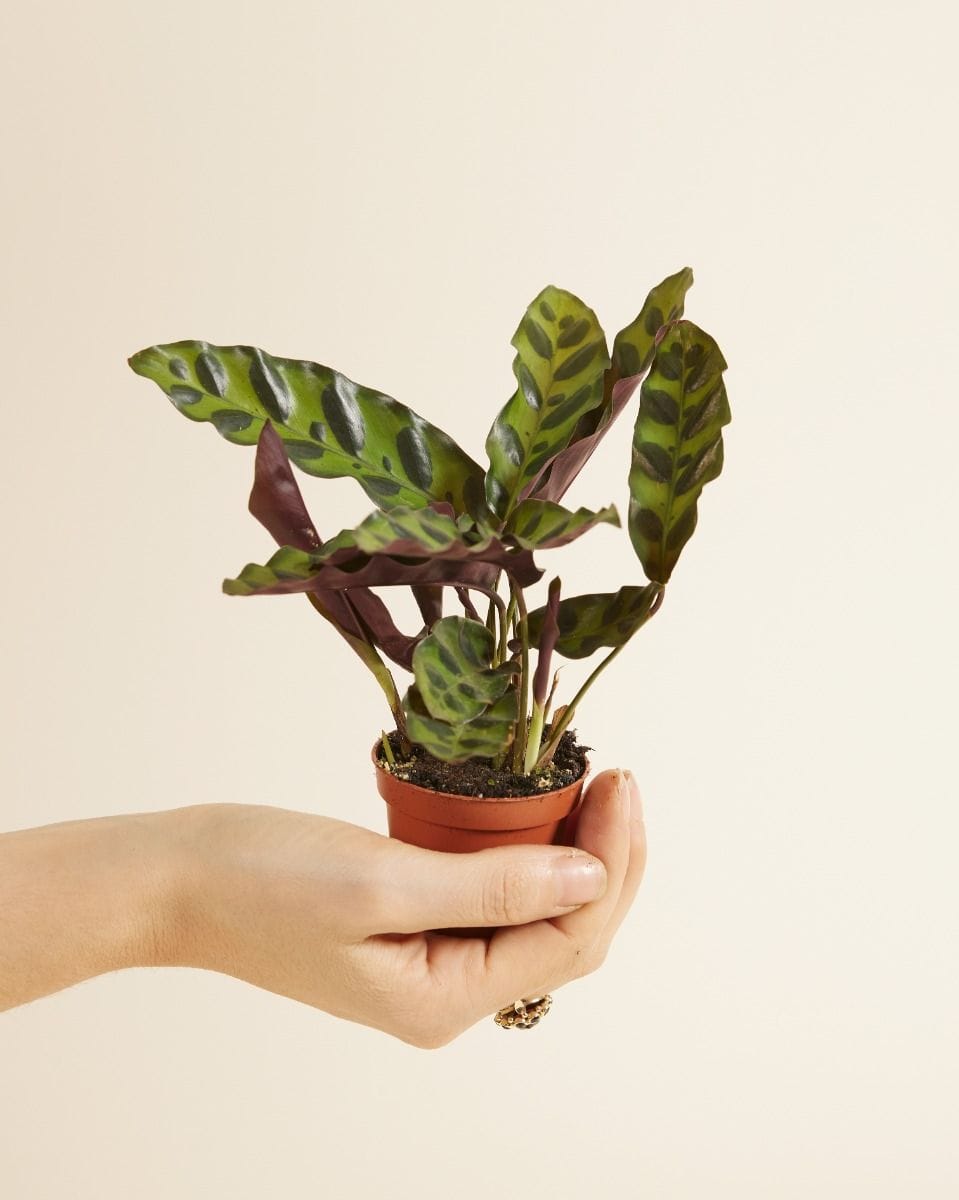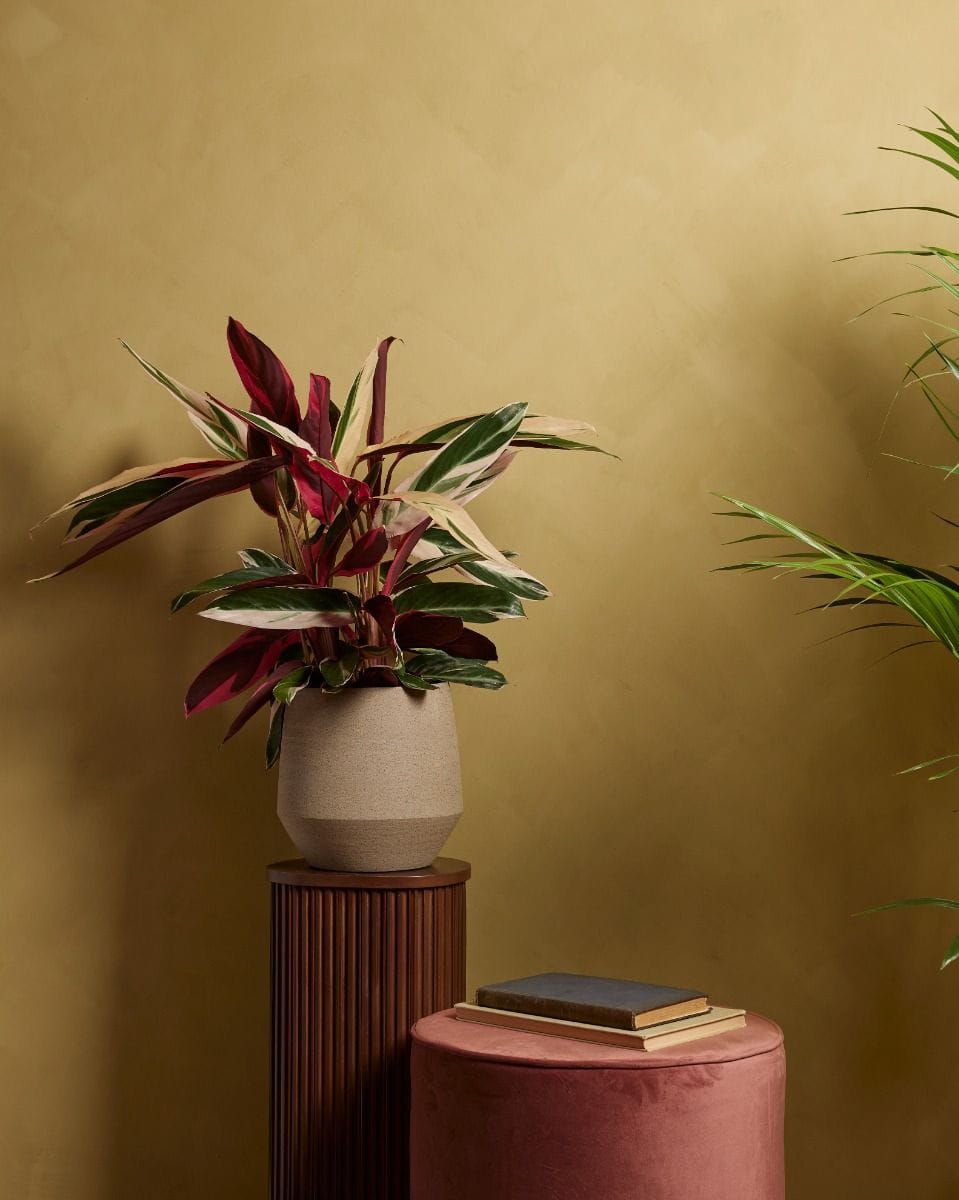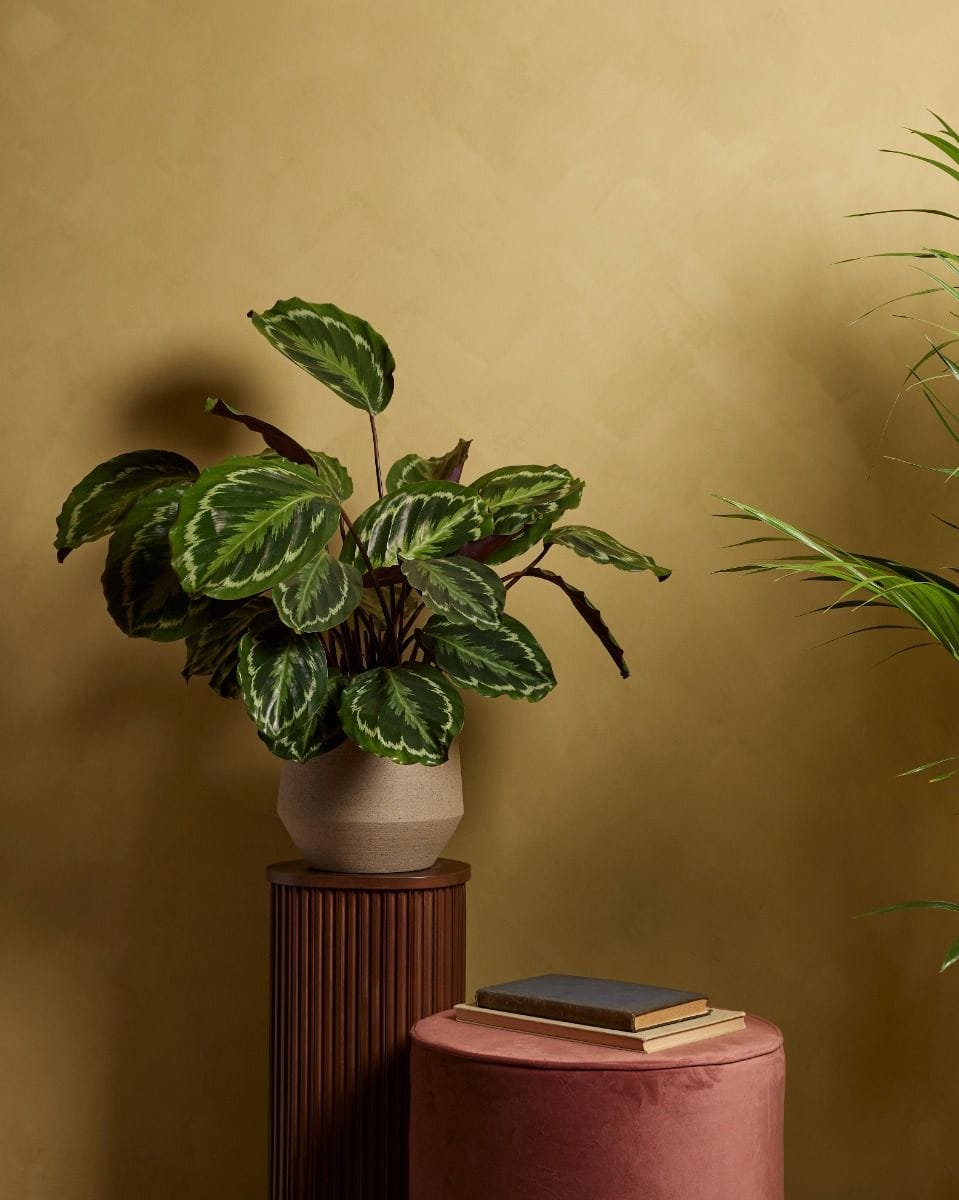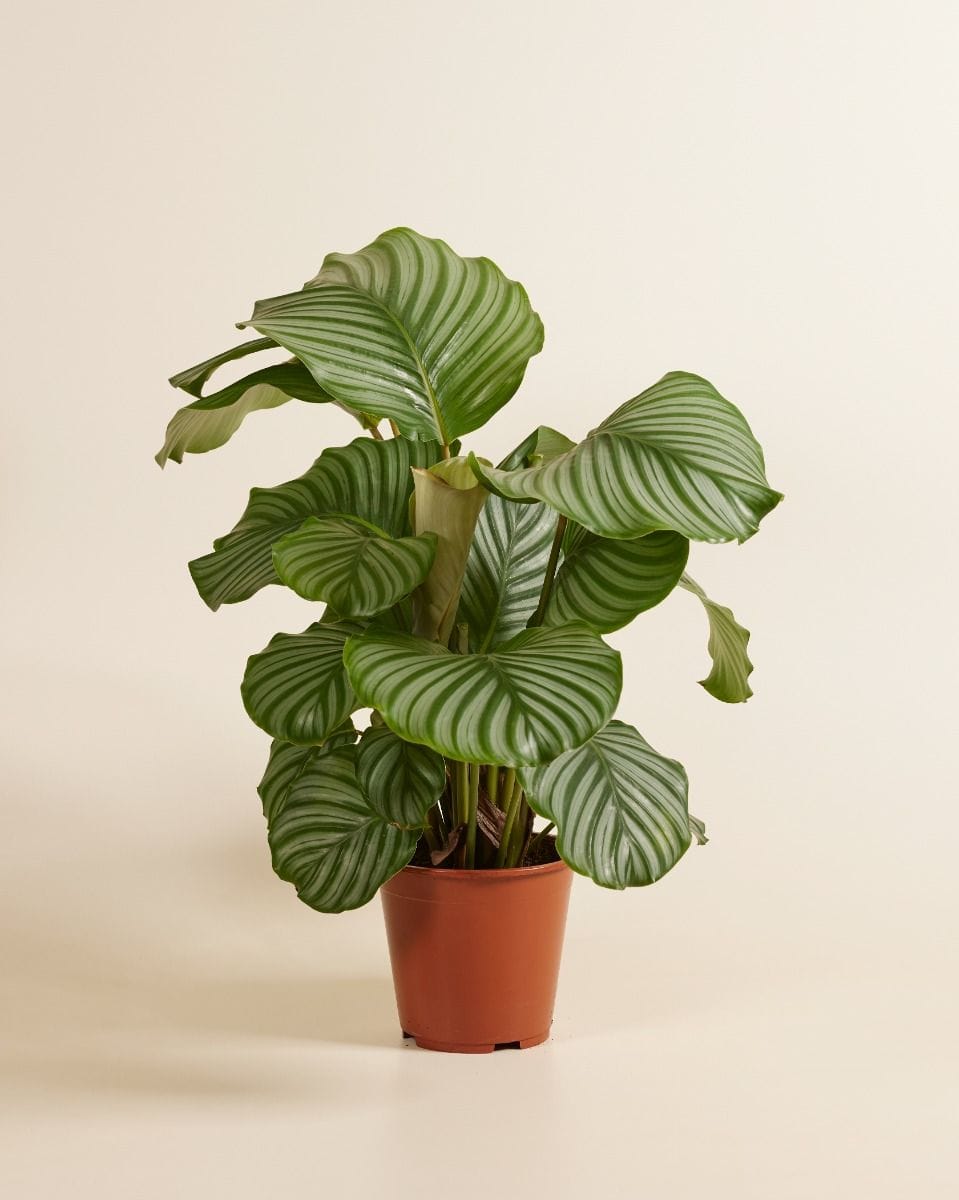In dit artikel
- 1 Calathea verzorgen: deskundige tips voor gezonde planten Calathea planten, ook bekend als Gebedsplanten, zijn populaire kamerplanten vanwege hun unieke en prachtige bladeren. Deze planten staan bekend om hun ovaalvormige bladeren, vaak voorzien van gedetailleerde ontwerpen en tinten groen, roze, paars en geel. Gebedsplanten zijn zo mooi dat het moeilijk is er een te missen in een plantenwinkel!
- 1.1 Verzorging van de Calathea plant: 10 deskundige tips om haar met succes te kweken
- 1.2 Calathea verzorgingstips
- 1.2.1 Licht en plaatsing
- 1.2.2 Water geven
- 1.2.3 Plantenvoeding
- 1.2.4 Temperatuur
- 1.2.5 Luchtvochtigheid
- 1.2.6 Verpotten
- 1.2.7 Potgrond
- 1.3 Calathea vermeerdering
- 1.4 Bloeiende Calathea
- 1.5 Meest voorkomende plagen en ziekten bij Calathea
- 1.6 Calathea varieteiten
- 1.7 Calathea veelgestelde vragen (FAQ)
- 1.8 Koop Calathea online bij PLNTS.com
Calathea verzorgen: deskundige tips voor gezonde planten
Calathea planten, ook bekend als Gebedsplanten, zijn populaire kamerplanten vanwege hun unieke en prachtige bladeren. Deze planten staan bekend om hun ovaalvormige bladeren, vaak voorzien van gedetailleerde ontwerpen en tinten groen, roze, paars en geel. Gebedsplanten zijn zo mooi dat het moeilijk is er een te missen in een plantenwinkel!
Calathea's staan er ook om bekend dat ze kieskeurig zijn, dus het vinden van de juiste watergift en vochtigheidsgraad kan enige tijd duren. Het is dus perfect voor iemand met meer ervaring of die bereid is er wat tijd aan te besteden.

Leuk weetje! Gebedsplanten hebben hun bijnaam te danken aan de unieke beweging van hun bladeren, die nyctinastie wordt genoemd. Ze vouwen hun bladeren omhoog (als biddende handen) als ze 's nachts gaan 'slapen' en openen hun bladeren weer in de ochtend.
Vanwege haar mensachtige dagelijkse circadiane ritme heeft de Calathea zelfs de bijnaam 'levende plant' gekregen. Alle Calathea's bewegen hun bladeren tot op zekere hoogte, maar sommige doen het dramatischer dan andere. Als het echt rustig is, en je hebt geluk, kun je zelfs een ritselend geluid horen als je Calathea plant haar bladeren beweegt!
Verzorging van de Calathea plant: 10 deskundige tips om haar met succes te kweken
- Zet je Calathea op een plek met indirect, helder licht. Vermijd direct zonlicht, want dat kan die mooie bladeren verbranden.
- Pas op dat je niet te veel water geeft. Wacht tot de helft van de bovengrond is opgedroogd voordat je weer water geeft. De grond moet gelijkmatig vochtig zijn, maar niet drassig.
- Houd de luchtvochtigheid hoog! Je hebt een hoge luchtvochtigheid nodig om Calathea er goed uit te laten zien. Zet een luchtbevochtiger bij de plant of zet hem op een bak met water en kiezels.
- Let op bruine bladranden. Dit kan je vertellen dat je luchtvochtigheid te laag is of dat je je bewateringsschema moet aanpassen.
- Gebruik een goed drainerende potgrond, want Calathea's zijn gevoelig voor wortelrot als de grond te vochtig is.
- Knip dode of vergeelde bladeren regelmatig af om de plant er gezond uit te laten zien en nieuwe groei te stimuleren.
- Plaats je Calathea niet in de buurt van tocht of warmtebronnen. Plotselinge temperatuurschommelingen kunnen de bladeren bruin of geel doen verkleuren.
- Controleer regelmatig. Door je plant regelmatig te controleren, kun je eventuele plagen vroegtijdig opmerken en maatregelen nemen om van het ongedierte of andere problemen af te komen voordat ze te veel schade aanrichten.
- Raak de bladeren niet te vaak aan, want de natuurlijke oliën op je huid kunnen de tere bladeren van de plant beschadigen.
- Verpot je Calathea elke één tot twee jaar om haar verse grond te geven en de groei te bevorderen. Kies een pot die iets groter is dan de vorige en zorg ervoor dat deze drainagegaten heeft.
Calathea verzorgingstips
Calathea's zijn ondanks hun poespas relatief gemakkelijk te verzorgen. Het is een zeer expressieve plant die snel visueel duidelijk maakt wanneer ze ongelukkig is.
Ontrolt jouw Calathea haar bladeren niet meer, of sluit ze 's nachts haar bladeren niet meer? Dan voelt ze zich waarschijnlijk niet zo lekker. Calathea volgt de bewegingen van de zon om de juiste hoeveelheid licht op te nemen, maar als ze te veel zonlicht krijgt, sluit ze haar bladeren om de hoeveelheid zonlicht waaraan ze wordt blootgesteld te verminderen.
Bladkrullen kan echter ook met de temperatuur te maken hebben: als ze het te koud krijgt, sluit de Calathea haar bladeren om zichzelf warm te houden. Aww, dat is eigenlijk best schattig, niet?

Licht en plaatsing
Omdat ze gewend is te groeien aan de voet van bomen in het dichte tropische regenwoud, verdraagt de Calathea vrij goed lage lichtomstandigheden, maar gedijt ze het best in gefilterd zonlicht.
Direct zonlicht kan haar tere bladeren permanent beschadigen en verbleken, dus pas op dat ze niet te dicht bij een zonnig raam wordt geplaatst. Gebruik een gordijn of rolgordijn om licht te filteren en de plant indirect licht te geven.
Water geven
De Calathea staat graag in vochtige - maar niet drassige - grond. Ze houdt niet van te lang natte voeten, dus regelmatig kleine beetjes water geven en niet te veel tegelijk is het beste. Je kunt de bovenste laag van de grond tussen twee waterbeurten door iets laten opdrogen, maar als je je vinger dieper in de grond steekt, mag hij er nooit helemaal droog uitkomen. Te weinig water kan ervoor zorgen dat haar bladeren uitdrogen en opkrullen.
Ze neemt vocht op via haar grote, brede bladeren, dus je kunt de vochtigheid opvoeren door haar bladeren te besproeien. Vergeet niet dat de bladeren van de Gebedsplant vrij gevoelig zijn, dus zorg ervoor dat je de sproeier instelt op de fijnste nevelstand.
Plantenvoeding
Calathea's hebben baat bij regelmatige bemesting, omdat ze daardoor beter gedijen en hun bladeren mooi blijven. Ze hebben echter geen zware bemesting nodig en kunnen gevoelig zijn voor een teveel aan voedingsstoffen. Overbemesting kan ook dat mooie bladpatroon aantasten. Wij raden je aan PLNTS plantenvoeding te gebruiken voor de beste resultaten.

Je kan je Calathea in de zomer elke één of twee weken wat plantenvoeding geven. Vermijd bemesting tijdens de wintermaanden, wanneer de plant in rust is, omdat ze dan niet actief groeit en geen extra voedingsstoffen nodig heeft.
Temperatuur
Als tropische plant houden Calathea's van warm weer. Temperaturen tussen 18 en 27°C, met een minimum van 16°C, zijn voor haar het beste. Houd jouw Calathea uit de buurt van temperatuurschommelingen.
Is het veilig om haar in de zomer (Europa) buiten te zetten?
Als je je Calathea uit de buurt houdt van extreme temperaturen en sterke wind, kun je haar in de zomer buiten zetten. Zet haar op een schaduwrijk terras of patio waar ze van het warme zomerweer kan genieten. Vergeet niet haar binnen te zetten voordat de nachten kouder worden.
Luchtvochtigheid
Calathea's houden van een hoge luchtvochtigheid. Houd de luchtvochtigheid rond de 50-70%. Ze verdragen een minimum van 40%, maar kunnen toch gestrest raken. Als de luchtvochtigheid in jouw kamer schommelt, kan dit ook stress veroorzaken bij je Calathea. Lees meer over luchtvochtigheid en hoe die te verhogen.
We hebben ongetwijfeld allemaal wel eens gehoord of meegemaakt dat de bladpunten van Calathea bruin worden. Een van de meest voorkomende oorzaken is te droge lucht. Het is vooral merkbaar in de winter, wanneer huizen erg droog worden. Probeer planten bij elkaar te zetten, een luchtbevochtiger te gebruiken of de bladeren vaak te besproeien om de luchtvochtigheid in huis te verhogen.
Verpotten
Verpotten moet ten minste om het andere voorjaar gebeuren om de plant verse grond en nieuwe voedingsstoffen te geven. Verstoor de wortels niet te veel en behandel de plant voorzichtig om stress te minimaliseren. Onze gids voor het verpotten van kamerplanten bevat veel handige tips voor je!
Potgrond
Voedingsrijke en goed drainerende grond is het beste voor deze planten. Idealiter ligt de pH-waarde tussen 6,0 en 6,5, wat licht zuur is. Het is belangrijk te voorkomen dat de grond te drassig wordt, want Calathea planten verdragen geen vochtige omstandigheden en kunnen moeite hebben met groeien in slecht drainerende grond. Voor de beste resultaten raden wij aan PLNTS organische potgrond te gebruiken.
Calathea vermeerdering
Calathea planten kunnen op verschillende manieren worden vermeerderd, onder andere door het stekken en delen van de planten. Houd er rekening mee dat ze gevoelig zijn voor temperatuurschommelingen en een lage luchtvochtigheid en dus niet altijd gemakkelijk wortelen.
Stap-voor-stap handleiding voor het vermeerderen met stengelstekken:
- Kies een gezonde, rijpe stengel met minstens één blad eraan.
- Snijd de stengel net onder een bladknoop door met een schoon, scherp mes of een schaar.
- Verwijder de onderste bladeren van de stek en laat twee of drie bladeren aan de bovenkant zitten.
- Maak een pot klaar met goed drainerende grond.
- Doop het afgesneden uiteinde van de stengel in stekpoeder, indien gewenst. Dit bevordert de groei van nieuwe wortels.
- Plant de stek in de pot en zorg ervoor dat de bladknopen onder de grond liggen.
- Geef de grond water en bedek de pot met een plastic zak of koepel om een vochtige omgeving te creëren.
- Zet de pot op een warme plaats met helder, indirect licht en geef regelmatig water.

Stap-voor-stap handleiding voor vermeerdering door kluitdeling:
- Kies een gezonde, volwassen Calathea plant die overgroeid is of meerdere kronen heeft.
- Haal de plant voorzichtig uit de pot en scheid de kronen of wortelkluiten.
- Plant elke kroon in een aparte pot gevuld met goed drainerende grond. Zorg ervoor dat alle wortels bedekt zijn met grond.
- Geef de grond water en plaats de potten op een warme plaats met helder, indirect licht. Vermijd direct zonlicht.
- Houd de grond vochtig en controleer de planten regelmatig om ervoor te zorgen dat ze het vocht en de vochtigheid krijgen die ze nodig hebben.
Na een paar weken moeten de stekken nieuwe wortels beginnen te produceren. Zodra de wortels zijn gevormd, kunt u de stek overplanten in een grotere pot. De beste manier om te zien of je stek wortels heeft, is er voorzichtig aan te trekken; als het stabieler aanvoelt, heeft het waarschijnlijk een wortelstelsel.
Bloeiende Calathea
Calathea's staan niet bekend om hun bloemen, maar hebben unieke bloemen. Calathea crocata is de enige die bekend is om zijn bloemen. Andere soorten bloeien minder vaak binnenshuis.
Bloeiwijzen met opzichtige gemodificeerde bladeren (vaak verward met bloemen) zijn meestal verborgen onder het gebladerte. Gewijzigde bladeren kunnen wit, groen of roze gekleurd zijn. Tussen de gevarieerde bladeren verschijnen driehoekige bloemen. Ze zijn bescheiden en klein, meestal wit.
Om de bloei te bevorderen, moet je je plant gelukkig en gezond maken. Dit betekent dat je haar moet voorzien van een hoge luchtvochtigheid en voldoende gefilterd natuurlijk licht en haar regelmatig moet voeden om ervoor te zorgen dat zij voldoende voedingsstoffen heeft.
Meest voorkomende plagen en ziekten bij Calathea
Calathea planten zijn over het algemeen goed bestand tegen plagen en ziekten, maar kunnen vatbaar zijn voor een paar veel voorkomende problemen. Trips, spint en bladluizen zijn enkele van de meest voorkomende plagen die de planten aanvallen en die vergeling en verwelking kunnen veroorzaken.
De PLNTSdokter helpt je daarbij! Op deze pagina vind je alle tips en trucs die je nodig hebt als jouw Calathea tekenen van ongedierte vertoont.

Calathea varieteiten
Calathea's zijn een prachtige en unieke aanvulling op elke kamerplantencollectie en maken zeker indruk met hun prachtige en levendige bladeren. Een van de meest populaire Calathea soorten is de Calathea Yellow Fusion, die bekend staat om haar kleurrijke bladeren. Andere populaire soorten zijn de Calathea Lancifolia Insigne, Calathea Warscewiczii en Calathea Makoyana. Sommige soorten Calathea staan bekend om hun unieke bewegingen, waarbij hun bladeren zich 's nachts opvouwen en 's ochtends weer opengaan.
Calathea veelgestelde vragen (FAQ)
Zijn Calathea planten giftig voor huisdieren en kinderen?
Calathea is een niet-giftige plant, dus ze is de perfecte match als je van zowel planten als huisdieren houdt.
Is Calathea een goede kamerplant?
Calathea, alias Gebedsplant, is een uitstekende kamerplant. Ook al is ze moeilijker te verzorgen, huizen met een hoge luchtvochtigheid zijn er goed voor. Ze hebben prachtige bladeren die in veel interieurs passen.
Is Calathea moeilijk te verzorgen?
Het is gemakkelijk om voor Calathea's te zorgen, ze hebben alleen een hoge luchtvochtigheid en een goede watergift nodig. De meeste huizen hebben een lage luchtvochtigheid (vooral in de winter), waardoor Calathea's bladproblemen en groeistoornissen krijgen.
Hoe red je een stervende Calathea plant?
De eerste stap is uitzoeken waarom hij uitdroogt. Observeer je plant, onderzoek de bodemvochtigheid en de lichtomstandigheden, controleer op plagen of ziekten, en gebruik een hygrometer om de luchtvochtigheid te bepalen.
Als je het probleem begrijpt, kun je een kleine verandering aan de plant aanbrengen (zoals verplaatsen, verpotten of je bewateringsschema veranderen). Knip alle beschadigde bladeren af en geef ze de tijd om te herstellen. Het kan moeilijker zijn om de plant te redden als de schade te groot is en er geen gezonde bladeren meer over zijn, maar je kunt proberen de plant te verpotten en een hoge luchtvochtigheid te geven; misschien verschijnen er dan nieuwe bladeren.
Waarom krullen mijn Calathea bladeren?
Een mogelijk probleem is droge lucht, want deze planten geven de voorkeur aan een hoge luchtvochtigheid. Bij een lage luchtvochtigheid gaan de bladeren van de plant zich oprollen om de transpiratie, d.w.z. het waterverlies, te beperken. Je kunt proberen de plant te besproeien met water of een luchtbevochtiger gebruiken om de luchtvochtigheid te verhogen.
Waarom wordt mijn Calathea geel?
Te veel water geven is een veel voorkomende oorzaak van vergelende bladeren bij deze planten, omdat ze gevoelig zijn voor wortelrot als ze te vochtig worden gehouden. Ook te weinig water kan de oorzaak zijn van gele bladeren. Zorg ervoor dat de helft van de grond opdroogt tussen twee waterbeurten door, maar laat haar niet helemaal uitdrogen.
Een tekort aan voedingsstoffen kan ook de oorzaak zijn, dus bemest de plant met een uitgebalanceerde, universele plantenvoeding. Zorg er ook voor dat jouw Calathea voldoende indirect, helder licht krijgt, maar geen direct zonlicht, want te veel zonlicht kan de bladeren geel kleuren. Bladluizen, wolluizen en trips kunnen ook vergeelde bladeren veroorzaken, dus houd deze plagen in de gaten. Een goede verzorging van je Calathea plant zou het probleem moeten oplossen.
Hoe snel groeit Calathea?
Calathea planten groeien matig en worden niet als snelle groeiers beschouwd.
Waarom hebben mijn Calathea bladeren bruine punten?
Droge lucht is meestal de oorzaak, omdat Calathea gevoelig is voor een lage luchtvochtigheid. Ook overbewatering, onderwaterzetting en temperatuurschommelingen kunnen dit probleem veroorzaken. De beste manier om bruine punten te voorkomen is om jouw Calathea consequent water te geven, de luchtvochtigheid hoog te houden en plotselinge temperatuurschommelingen te vermijden.
Moet ik mijn Calathea elke dag besproeien?
Calathea planten houden van een hoge luchtvochtigheid, dus kan het nuttig zijn om de bladeren te besproeien. Het is echter niet nodig om de bladeren elke dag te besproeien. Eén of twee keer per week de bladeren besproeien zou de plant van het nodige vocht moeten voorzien.
Kan ik mijn Calathea water geven met kraanwater?
Over het algemeen kun je je Calathea water geven met kraanwater, maar het is belangrijk om rekening te houden met de kwaliteit van je water, afhankelijk van waar je woont. Als je hard water hebt, kan het een goed idee zijn om gefilterd of gebotteld water te gebruiken voor uw Calathea. Hard water met veel mineralen kan zich ophopen in de grond en bruine punten op de bladeren veroorzaken.
Koop Calathea online bij PLNTS.com
Bij PLNTS.com kan je verschillende soorten Gebedsplanten kopen, zoals de Calathea Zebrina, de Calathea Orbifolia en de Calathea Medallion. Met zoveel soorten om uit te kiezen, is er een Calathea voor iedereen!
Of je je Calathea's nu vanaf het begin groot wilt of ze liever van kleine BabyPLNTS tot volgroeide PLNTS kweekt - koop Calathea online bij PLNTS.com

